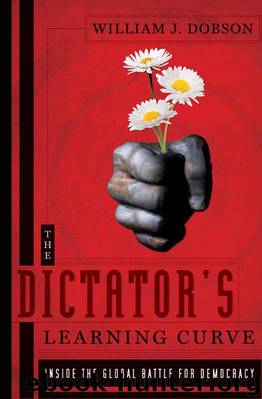The Dictator's Learning Curve: Inside the Global Battle for Democracy by William J. Dobson

Author:William J. Dobson
Language: eng
Format: mobi, epub
ISBN: 9780385533362
Publisher: Knopf Doubleday Publishing Group
Published: 2012-06-05T04:00:00+00:00
A Show of Force
It looked like a party: young men and women dancing to rock music and belting out songs. Wearing orange hats, scarves, armbands, and ribbons, tens of thousands of Ukrainians, many of them young people, lived in the streets of Kiev for nearly three weeks. They had flooded Independence Square and other corners of the capital to protest a stolen election and stand up for their candidate. As the November temperatures fell, they bundled up, had a little more to drink, and joined together in chanting, “Together, we are many! We cannot be defeated!” Before the end of the year, this outburst of “people power” had overturned a fraudulent election and returned Ukrainians to the voting booth, where they democratically elected the country’s leading opposition candidate.
The colorfully named Orange Revolution was hailed as a peaceful democratic uprising. And it was. But the youth activists who had played a role in organizing the street protests in Kiev that winter had not worked from an entirely blank slate. The Ukrainian youth movement, known as Pora, had benefited from consultations and advice from Serbia’s Otpor, the youth who had helped bring down Miloševic in 2000. They had also had conversations and shared ideas with Kmara, the young leaders who helped propel the Rose Revolution in Georgia in 2003. And if you looked closely at the sea of orange in Kiev’s “tent city” that November, you would have seen that others had come to learn from the Ukrainian experience. Young Kazakhs had come to see the protests firsthand. Belarusian activists mingled in the crowd and even hoisted their national flag in support of their new Ukrainian friends. Young people from across former Soviet republics were there to see what it meant to make a “color revolution.”
The Kremlin did not need to wait until it saw Russian youth in the streets of Moscow or St. Petersburg to learn its lesson. Having witnessed the role that opposition youth groups played in Serbia, Georgia, and especially in Ukraine during the Orange Revolution, the Kremlin decided to manufacture a youth movement of its own. The result is Nashi. The group, which struck a militant nationalistic tone from the beginning, is today one of the key instruments for intimidating and harassing opposition leaders, civil society activists, and Kremlin critics. On the day I arrived in Moscow in April 2010, Nashi (which literally means “Ours”) was celebrating its fifth anniversary. The celebration’s keynote speaker was none other than Putin’s right-hand man, Vladislav Surkov, then the Kremlin’s leading ideologist who is believed to be behind Nashi’s creation. Surkov stirred a raucous crowd of Nashi delegates, roughly two thousand twentysomethings. “We see what’s happening in Kyrgyzstan—that means we are needed and have to be at our posts,” Surkov told the crowd at a high-end Moscow conference hall, referring to the near civil war that had recently broken out on Russia’s border. “Those who chose for themselves the political fight will never be able to relax again.” His remarks were followed by Vasily Yakemenko, Nashi’s leader and official founder.
Download
The Dictator's Learning Curve: Inside the Global Battle for Democracy by William J. Dobson.epub
This site does not store any files on its server. We only index and link to content provided by other sites. Please contact the content providers to delete copyright contents if any and email us, we'll remove relevant links or contents immediately.
| Anthropology | Archaeology |
| Philosophy | Politics & Government |
| Social Sciences | Sociology |
| Women's Studies |
The Secret History by Donna Tartt(18865)
The Social Justice Warrior Handbook by Lisa De Pasquale(12143)
Thirteen Reasons Why by Jay Asher(8801)
This Is How You Lose Her by Junot Diaz(6804)
Weapons of Math Destruction by Cathy O'Neil(6152)
Zero to One by Peter Thiel(5693)
Beartown by Fredrik Backman(5609)
The Myth of the Strong Leader by Archie Brown(5429)
The Fire Next Time by James Baldwin(5253)
How Democracies Die by Steven Levitsky & Daniel Ziblatt(5134)
Promise Me, Dad by Joe Biden(5090)
Stone's Rules by Roger Stone(5029)
A Higher Loyalty: Truth, Lies, and Leadership by James Comey(4851)
100 Deadly Skills by Clint Emerson(4845)
Rise and Kill First by Ronen Bergman(4706)
Secrecy World by Jake Bernstein(4653)
The David Icke Guide to the Global Conspiracy (and how to end it) by David Icke(4629)
The Farm by Tom Rob Smith(4442)
The Doomsday Machine by Daniel Ellsberg(4420)
